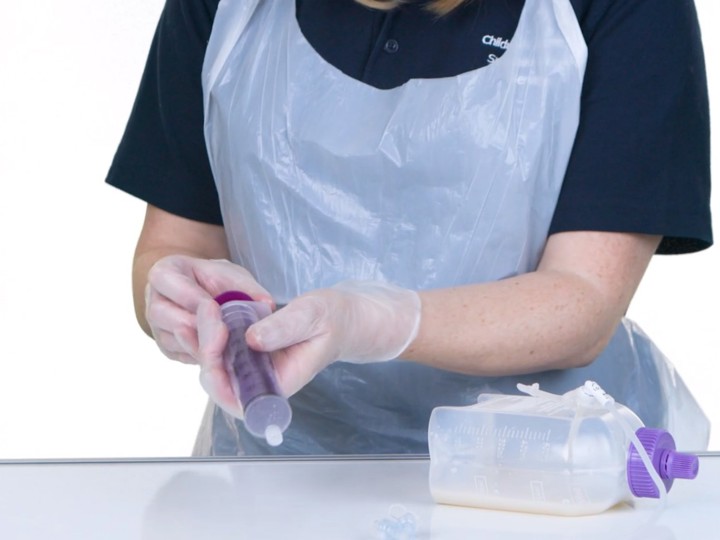Live demonstrations

This page has a series of online live demonstrations that have been specifically created to support families and professionals. Please take your time to watch through each session.
Objectives of the session
- To be able to deliver the same standards of high quality care to all children and young people.
- To be able to provide care safely, to a high standard and to understand the relevance of the training.
- To feel confident and competent providing the care you deliver.
Gastric decompression or venting
You will need a purple 60ml enteral syringe and your child's enteral feeding device, a Mic-Key button with extension set or a peg tube. Afterwards, observe your child to make sure that this has helped with their wind.
How to do gastric decompression or venting: You will need a purple 60ml enteral syringe and your child's enteral feeding device, a mickey button with extension set or a peg tube.
Remove the barrel from the syringe and attach the syringe to end of the extension set or the peg tube. And clamp the tube and allow any gas or wind or air to be expelled from the child's tummy through their button and the tube into the barrel of the syringe. You may hear gurgling noises or see bubbling. Some of the contents may come into the tube. This is fine.
Some parents like to massage their child's tummy. If you have been asked to do this, then please do so. Gently working in a clockwise direction. Once you're happy that the air has been expelled, allow the contents to run into the stomach. Close the clamp. And remove the extension set if you are not going onto feed. Line up the two black dots and remove the extension set from the button and close the clamp. Observe your child to make sure that this has helped with their wind.
Gravity bolus feed
You will need your child's feed as per their home enteral feeding plan, a syringe for any water flushes, a gravity feeding set, and the child's Mic-Key button and extension set or a peg tube. Before starting, check your child's feed plan to check you have the correct feed and that it is in date and hasn't curdled.
How to give a gravity bolus feed: You need your child's feed, as per the home enteral feeding plan, a syringe for any water flushes, a gravity feeding set and your child's mic-key button and extension set or peg tube.
Make sure that the feed is in date. Check your child's feed plan to make sure you have the correct feed and check that it has not curdled and looks fine to use. Take out your gravity feeding set and close the roller clamp, making sure you have a clean surface to work on. If you need to decant your feed, do so into a container or an empty bottle. Pour a small amount of feed or water into the barrel of the syringe. We need to prime this so that there's no air in the tubing. To do so, open the roller clamp and allow some of the feed or water to flow through the tube until it reaches the end. Once it's done so, close the roller clamp.
Attach the end of the feeding set to your child's gastrostomy tube or primed and flushed mic-key extension set. Observe the child, make sure they're comfortable. Open the clamp and open the roller clamp by rolling the clamp upwards. This will allow the water or feed to flow through the tube into the child. The higher that you hold the tube, the faster it will flow, the lower you hold the tube, the slower it will flow. Before the volume of liquid reaches the end of the barrel of the syringe, clamp the tube and top up to the required feed volume. Open the clamp and allow the feed or liquid to flow.
Control the speed with raising or lowering the barrel and how far you open or close the roller clamp. This should be a slow feed of around ten minutes. Continued to repeat this process until the required feed volume has been given.
Once you're reaching the end of the feed, observe the feed and allow it to travel to the bottom of the barrel. Before it reaches the end, close the roller clamp so as not to introduce any air into the child. Disconnect from the extension set. Close the clamp. Make sure the child is comfortable and discard of your equipment. Remove your apron and gloves and wash your hands.
Flocare feed (Mic-Key)
You will need a flocare feeding pump, a feed giving set, your child's feed as per their home enteral feeding plan and the child's Mic-Key button and extension set. When the feed is complete the pump will sound an alarm to tell you that it has finished. Press the start/stop button to stop the alarm.
How to give a feed using a flowcare feed pump through a mic-key button: You will need the flowcare feeding pump, a feed giving set, the child's feed, as per their whole mental feeding
plan, the extension set and child’s mic-key button.
Remove the feeding set from it’s packet. Make sure any medicine feeding ports are closed and the roller of clamp is closed. Remove the end from the feeding set and the cap from your feed, attach the feed giving set into the feed. Make sure this is closed securely to avoid any leaks. Turn on the pump. It’ll go through a series of checks and then get to a home screen. Open the cover and insert the feed giving set into the pump. This will only go in one way and the flat surface should be uppermost. Make sure that the two entry and exit points are clear when you close the cover. We need to fill the set with feed so that there's no air and we don't introduce air into the child's tummy. To do this, press and hold the “fill set” button. The pump will beep and start taking the feed through the set. Make sure the roller clamp is open. The pump may stop when the feed reaches the end. Sometimes this doesn't happen, and you have to press “fill set” again to stop it. Press “fill set” set to stop. Make sure you keep the end of your feed giving set clean.
We need to set the pump to the required rate and dose. Use your child's home enteral feeding plan to tell you what they should be. To set the dose, press “dose”, use the plus and minus keys to increase or decrease the amount. We need to then set the rate and how fast it will run. Again, refer to your child's feeding plan and press the “ml/h” (mils per hour) button. Use the plus and minus buttons to increase or decrease the rate. Once this is set to your desired amount, press the “info” button, this will tell you how much has previously gone through the pump. If you want to clear this, press “info” and “clear” to clear. Recheck your dose and you're rate, and your pump is ready. Remove the cap from the end of the feed giving set and the cap from the end of your child's extension set. The extension set should have already been primed and flushed. Attach the feed set to the extension set. Unclamp the clamp. And press “start/stop”. The pump will run and deliver the feed through the giving set and into the child.
Your child may have a stand and the pump and feed can sit in the stand and go with your child. When the fed is complete, the pump will alarm to tell you that it's finished.
Press the “start/stop” button to stop the alarm. Clamp the tube, disconnect and flush as taught previously.
Water flush (Mic-Key)
You will need some water, an enteral feeding syringe, a Mic-Key extension set and your child's Mic-Key button with the child. Observe your child at all times to make sure that they are comfortable and there are no problems.
How to draw up and administer a water flush through a mic-key button. You will need some water, an enteral feeding syringe, a mic-key extension set and your child's mic-key button with the child.
First of all, draw up around 20mls of water. Depress the plunger to withdraw any air and press the plunger upwards to expel the air. Take your extension feeding set, open the cap and attach the syringe. Unclamp the clamp. And press the water through the syringe and the extension set to expel any air. Stop when the water reaches the end. Clamp the tube and remove the syringe, making sure you maintain a clean technique. Access your child's mic-key button, which is demonstrated here. The flow care container just represents the child's stomach. Open the cap. Line up the two black dots, one on the extension set and one on the mic-key button. Press the extension set into the mic-key button, supporting the button so as not to cause damage to the child's stomach. Rotate the mic-key button half a turn to lock it into place. Draw up the required amount of water for your child's flush as per their feeding plan. Expel any air from the top of
the syringe so as not to introduce any air into the child's tummy.
Attached to the syringe, to the end of the extension set. Open the clamp and slowly flushed the water into the child. Observing the child at all times to make sure that they are comfortable and there are no problems. The water should flow freely and easily.
If it does not flow, there may be a blockage. Once complete, close the clamp, remove the syringe and close the cap. If your child requires a feed following the flush, you can now go on to set up and administer the feed.
Bolus feed via a PEG tube
Refer to the feed regime for the individual child for the child's details. Ensure your hands are clean and collect all the equipment required. This includes the feed which is in date and at room temperature, purple syringes, water and disposable aprons and gloves. Always observe the child throughout the procedure to make sure they are not experiencing any pain or discomfort.
Bolus feed via a NG tube
Refer to the child's feed plan to check the details. Ensure hands are clean and collect all equipment required. This includes the child's individualised care plan, the feed as per the care plan, syringes for water, flush and feed, Ph paper, purple syringe and water. Always observe the child throughout the feed and check for any vomiting, gagging, retching, pain, discomfort or leak.
Gravity feed via a NG tube
Refer to the child's individualised care plan to check the details. Ensure hands are clean and collect all equipment required. This includes the child's individualised care plan, feed as per the care plan, syringe for water and flush, syringe to aspirate the NG tube, Ph strips and gravity feed set.
Pump feed via a PEG tube
Refer to the feed regime for the individual child for the child's details. Ensure hands are clean and collect all equipment required. This includes the infinity flocare pump that is fully charged, the feed which is in date and at room temperature, infinity pump giving set, purple syringe, water and disposable gloves and apron. Observe the child for any vomiting, gagging or retching.
Pump feed via a NG tube
Refer to the child's individualised feed care plan to check the details. Ensure hands are clean and collect all equipment required. This includes the individualised care plan, syringe for water flush, syringe to aspirate from the NG tube, Ph strips, giving set, feed, infinity pump, water and disposable gloves and apron.
Last reviewed: 1 November, 2023

